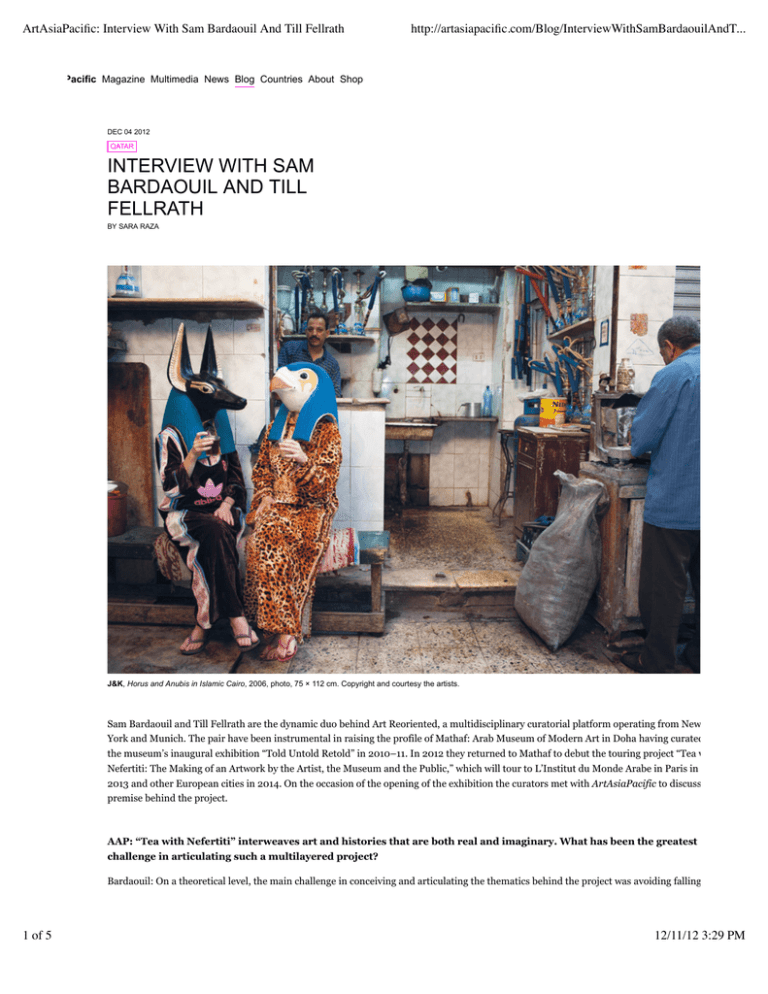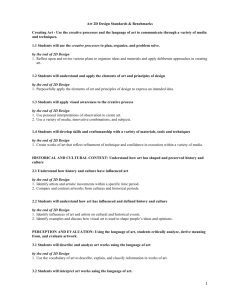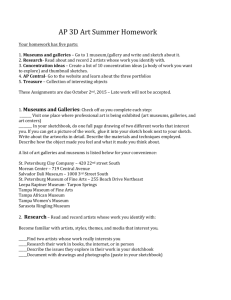ArtAsiaPacific: Interview With Sam Bardaouil And Till Fellrath
advertisement

ArtAsiaPacific: Interview With Sam Bardaouil And Till Fellrath http://artasiapacific.com/Blog/InterviewWithSamBardaouilAndT... ArtAsiaPacific Magazine Multimedia News Blog Countries About Shop DEC 04 2012 QATAR INTERVIEW WITH SAM BARDAOUIL AND TILL FELLRATH BY SARA RAZA J&K, Horus and Anubis in Islamic Cairo, 2006, photo, 75 × 112 cm. Copyright and courtesy the artists. Sam Bardaouil and Till Fellrath are the dynamic duo behind Art Reoriented, a multidisciplinary curatorial platform operating from New York and Munich. The pair have been instrumental in raising the profile of Mathaf: Arab Museum of Modern Art in Doha having curated the museum’s inaugural exhibition “Told Untold Retold” in 2010–11. In 2012 they returned to Mathaf to debut the touring project “Tea with Nefertiti: The Making of an Artwork by the Artist, the Museum and the Public,” which will tour to L’Institut du Monde Arabe in Paris in 2013 and other European cities in 2014. On the occasion of the opening of the exhibition the curators met with ArtAsiaPacific to discuss the premise behind the project. AAP: “Tea with Nefertiti” interweaves art and histories that are both real and imaginary. What has been the greatest challenge in articulating such a multilayered project? Bardaouil: On a theoretical level, the main challenge in conceiving and articulating the thematics behind the project was avoiding falling 1 of 5 12/11/12 3:29 PM ArtAsiaPacific: Interview With Sam Bardaouil And Till Fellrath http://artasiapacific.com/Blog/InterviewWithSamBardaouilAndT... into the redundant dynamics of postcolonial art historical rhetoric and identity politics. Fellrath: We wanted to explore the positioning of both artists and artworks within different contexts and shift the focus toward the contested mechanisms of visual and literary display through which narratives are associated with art and artists. Bardaouil: The only way to do that was to focus on specific examples of artworks and artists and the journeys that they made in time and place and allow for these incidents to speak for themselves. What about on a logistical level, how did you manage to bring so many diverse works and objects together? Fellrath: On a logistical level, the biggest challenge was to identify and secure artworks that help construct the story the exhibition seeks to tell. In a period of more than two years we managed to put together a carefully conceived selection of almost 150 artworks and archival documents coming form more than 80 lenders all over the world. It’s interesting that you withhold all attempts to fall within the stereotypical rubrics of identity politics and reject ethnicity labels when so many “regional” curatorial shows fall into this trap. How are curatorial borders shifting within museum practice to accommodate this line of thought? Fellrath: To be frank they are not adapting fast enough or clearly enough. Museums still have acquisition committees that separate the artists and artworks they collect into regions that are ideologically and historically problematic to say the least. We can see the hesitation lurking behind the naming of new Islamic art galleries opening at various museums over the last couple of years such as the Metropolitan Museum of Art and the Louvre. Museums and art spaces still put on shows about “Contemporary Chinese Art” or “Japan Now” or “New Art from the Middle East.” Bardaouil: We are by no means negating the specificity of context and overall environment and lineage (where and when applicable), which can have a certain presence in the work of any artist, but we are against using that as a legitimization for certain associations and expectations. Would you say that within the context of your exhibition at Mathaf you try to trouble this notion within museum practice by making the problematics more explicit? Bardaouil: Yes, absolutely. Take the example of artist Mahmoud Moukhtar. In 1930, Moukhtar had a solo show at Galerie Bernheim-Jeune in Paris. The title printed on the cover of the catalogue read “L’Art Egyptien Contemporain.” His name followed after. The same gallery was showing other modernists artists at the time such as Picasso. When they showed Picasso however, they did not label the show “L’Art Espagnol Contemporain.” The point being that the gallery, because it introduced Moukhtar’s work by way of his nationality, framed him as the cultural “other.” Fellrath: This problematic labeling still continues today, with all the shows that look at artists through the lens of ethnicity and nationality, transforming them into cultural ambassadors and ethnographic documents. The practice of Orientalism is still a rampant trend and by no means exclusive to museums: “Self-Orientalism” is still current in contemporary arts, usually self-inflicted by artists or imposed by their curators and critics. What are your views on this? Fellrath: We can cite endless examples of artists and cultural practitioners who, in the wake of certain political events in the region, shifted their practice towards the incorporation of calligraphy, scenes of protests and images of veiled women. The number of exhibitions that promise a comprehensive deconstruction of the politics of revolution or an insight into the conflicts at play in certain parts of the world is ridiculous. Bardaouil: Of course, the role that auction houses have been playing since the mid-2000s in promoting and commodifying the “Art of the Middle East, Turkey and Iran” (another ridiculous label) has not helped either. Fellrath: We have all witnessed how certain galleries have been pushing their artists to produce work that fits the label and echoes some of the themes and forms that fall within the neo-Orientalist or neo-exotic brand guidelines. 2 of 5 12/11/12 3:29 PM ArtAsiaPacific: Interview With Sam Bardaouil And Till Fellrath http://artasiapacific.com/Blog/InterviewWithSamBardaouilAndT... NIDA SINNOKROT’s installation of two JCB 1CX backhoe arms from “Tea with Nefertiti” in the right-hand image appropriates the ka motif from a first century AD stela, seen at left. Courtesy Sharjah Art Foundation. What was refreshing about “Tea with Nefertiti” was that it was more of an exhibition about fluidity and the movement of people and ideas, which are never stagnant. Bardaouil: Absolutely, and this is why the show does not classify the artists or artworks based on nationality, genre and period, but rather by the incidents of cultural transfer and thematic negotiation that any artist at any time and from anywhere can engage with. Artists such as Giacometti and Moukhtar each made their own contributions to modernity. Fellrath: We even place an Ai Weiwei Neolithic vase with a Coca Cola logo alongside a historical bowl from Egypt’s Fatimid period in order to re-inform the semantics and function of each of the two artworks. Underpinning the exhibition is a deeper art historical exploration into the Art and Liberty movement in the early 20th century. However, this group has largely remained absent from the dominant modernist art historical discourse. Why do you think that was? Bardaouil: The group was extremely important in the late 1930s and 1940s in offering a counter narrative and the voice of dissent. Challenging the conflation of nationalism and artistic production in Egypt—which was a response to the rigid parameters that were at play within the local arts scene from the beginning of the 20th century onward—was at their core. In their literature, they criticized all expectation forced on Egyptian artists to work in a neo-Pharaonic style, to build the national project, while denouncing the iconic status allocated to Moukhtar. In their exhibition catalogues, the Art and Liberty group refused to refer to the nationalities of the participating artists and highlighted instead the individual stylistic preferences of each artist. What other projects are you currently working on? Fellrath: We have a major solo show for a leading international artist planned for Mathaf next year. In addition, we are curating the Lebanese Pavilion at next year’s Venice Biennale and will showcase the work of Akram Zaatari. Bardaouil: The pavilion will trouble the notion of what a national pavilion has come to represent. We are also working on a publication in keeping with the theme of the problematics of representation of Arab artists within the context of politics. 3 of 5 12/11/12 3:29 PM ArtAsiaPacific: Interview With Sam Bardaouil And Till Fellrath http://artasiapacific.com/Blog/InterviewWithSamBardaouilAndT... MAHMOUD MOUKHTAR, Khamasin Wind, 2012 replica of 1929 original, white stone, 57 × 41 × 21 cm. Courtesy Mahmoud Moukhtar Museum, Cairo. Related BLOG Field Trip: Doha QATAR REVIEWS QATAR NEWS APR 2012 Three Inaugural Exhibitions at the Arab Museum of Modern Art (Mathaf) MAR 2011 Mathaf’s Director Steps Aside to Pursue Research QATAR REVIEWS MAR 2012 Saraab: Cai Guo-Qiang MAR 2012 4 of 5 12/11/12 3:29 PM







